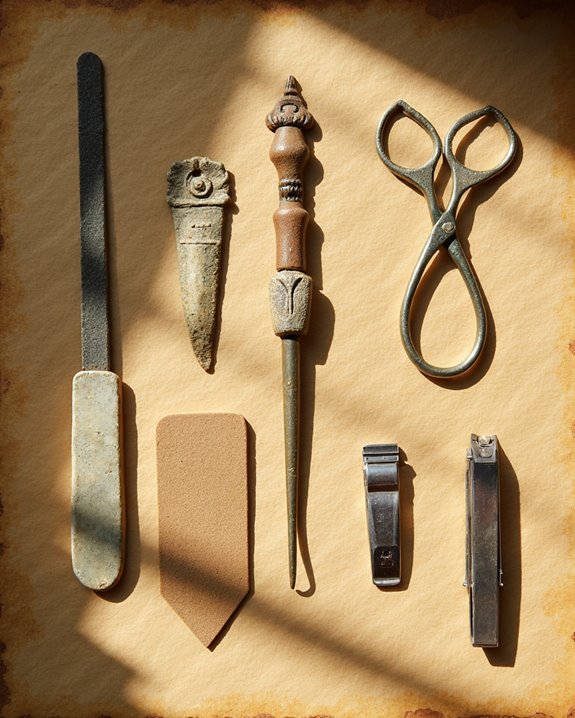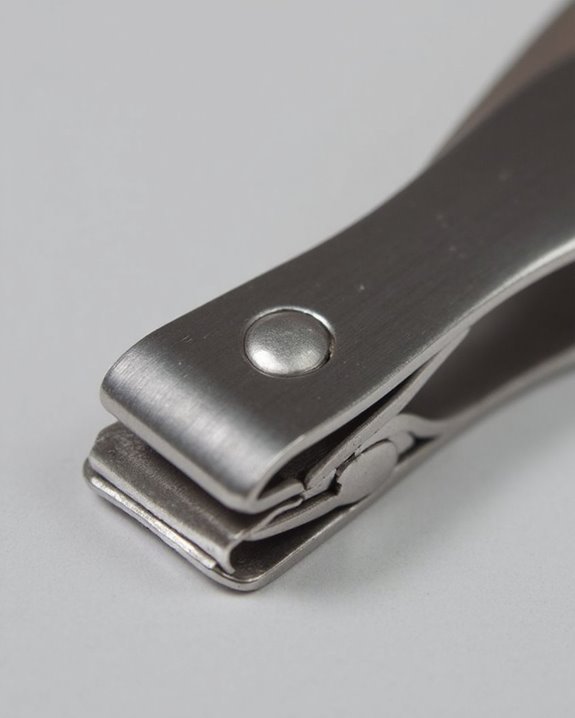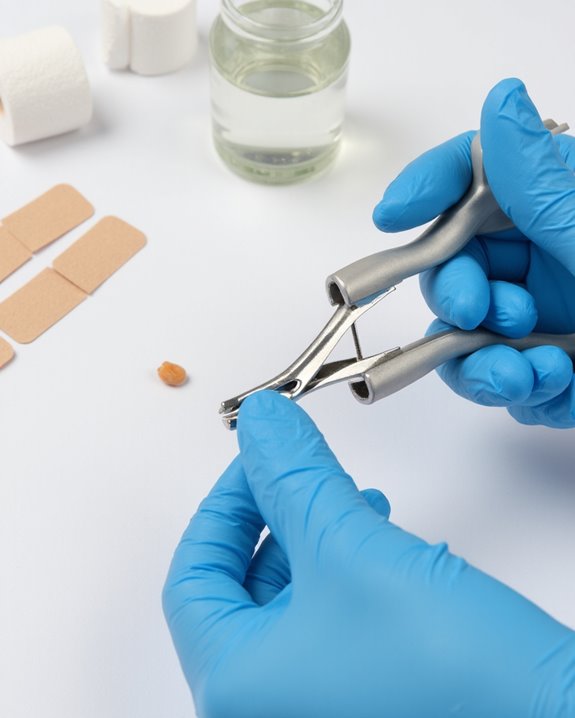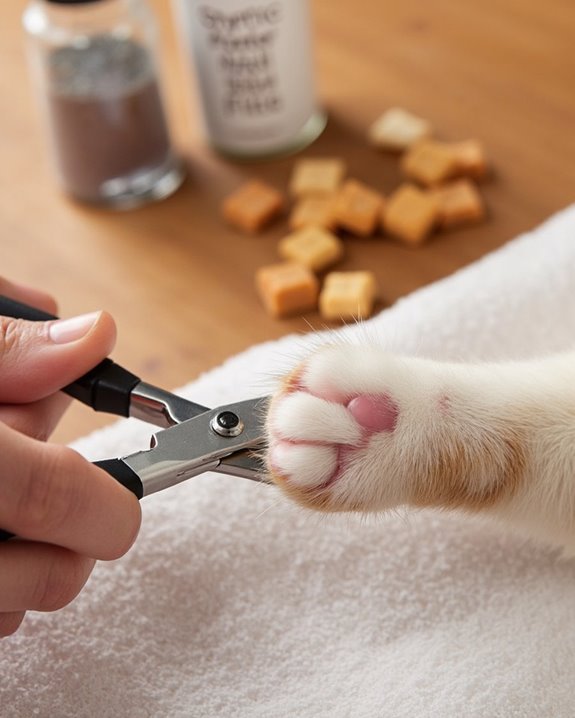Before modern nail clippers, ancient people relied on several methods to manage nail growth. Early humans used natural abrasion from daily activities like barefoot walking and manual labor. As societies developed, people employed rudimentary tools made from stone, bone, and shells for more precise trimming. Some cultures practiced biting or chewing nails after bathing when they were softer. Archaeological evidence from the 8th century BC shows specialized implements that reflected evolving hygiene standards. These fascinating adaptations reveal much about our ancestors’ ingenuity.
Key Takeaways
- Ancient humans primarily relied on natural abrasion from daily activities like barefoot walking and manual labor for nail maintenance.
- People would bite or chew their nails after bathing when the tissue was pliable, using teeth to trim and remove irregular edges.
- Natural materials such as stones, shells, and pumice were used as primitive nail files for shaping and shortening.
- By the 8th century BC, specialized implements crafted from bone and stone emerged for more precise nail cutting.
- Greeks and Romans maintained short nails for hygiene purposes, as longer nails could harbor pathogens and accumulate dirt.
Natural Nail Wear in Prehistoric Times
Abrasion was our ancestors’ natural manicurist. In prehistoric times, humans didn’t need nail clippers or scissors because their daily activities provided constant nail maintenance. When our ancestors walked barefoot across rough terrain, their toenails experienced significant natural wear, keeping them at manageable lengths without deliberate trimming.
The demands of survival created a perfect balance between nail growth and abrasion. Manual labor like digging for tubers, scraping animal hides, or crafting stone tools naturally chipped and shortened fingernails, similar to what we observe in great apes today. With toenails growing approximately 1.6 millimeters monthly, this passive wear from ground contact effectively counteracted growth. Without modern footwear or sedentary lifestyles, prehistoric humans relied entirely on environmental interactions to maintain their nails, unlike our contemporary need for specialized tools.
Bite and Pull: The Earliest Nail Management Method
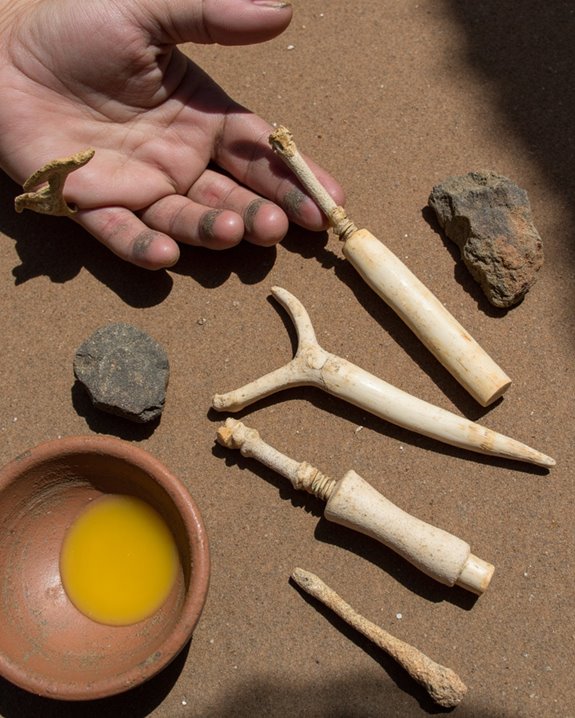
When natural abrasion wasn’t enough, what did our ancestors do to manage their growing nails? The evidence points to one of humanity’s most primal solutions: their own teeth. Ancient humans cut their nails primarily through biting and pulling, a straightforward yet effective method that predated specialized tools by millennia.
I’ve found that our ancestors would typically bite their fingernails after activities like bathing, when the nail tissue was more pliable and easier to trim. For toenails, they’d adopt similar techniques, using their incisors to carefully remove excess growth. When confronted with problematic hangnails or irregular edges, they’d tug and pull using their teeth to create smoother contours. This oral approach to nail maintenance wasn’t merely convenient—it represented an essential adaptation in human grooming practices before technological innovation.
Ancient Tools for Nail Trimming
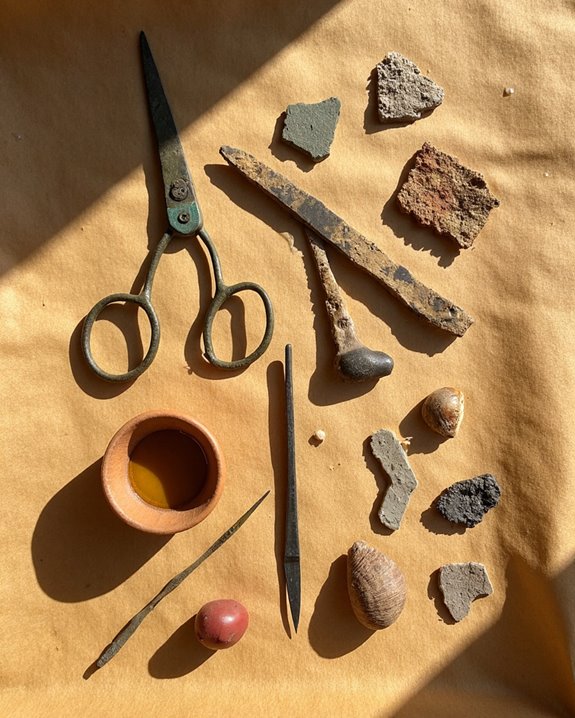
The evolution of nail trimming technology marks a significant advancement in human grooming history, shifting our ancestors from oral methods to more sophisticated approaches. Archaeological evidence suggests that by the 8th century BC, humans had developed specialized implements for this purpose, crafted from readily available materials in their environment.
I’ve found that our ancestors ingeniously fashioned rudimentary tools from stone, bone, and shells, creating primitive yet effective nail management systems. They would carefully shape these materials into cutting edges or abrasive surfaces, allowing for more precise grooming than biting could provide. Some early civilizations even developed specialized instruments resembling modern nail files, using rough natural surfaces to gradually wear down nail length and shape the edges with surprising precision, particularly when finer appearance became culturally important.
Evolutionary Aspects of Human Nail Growth
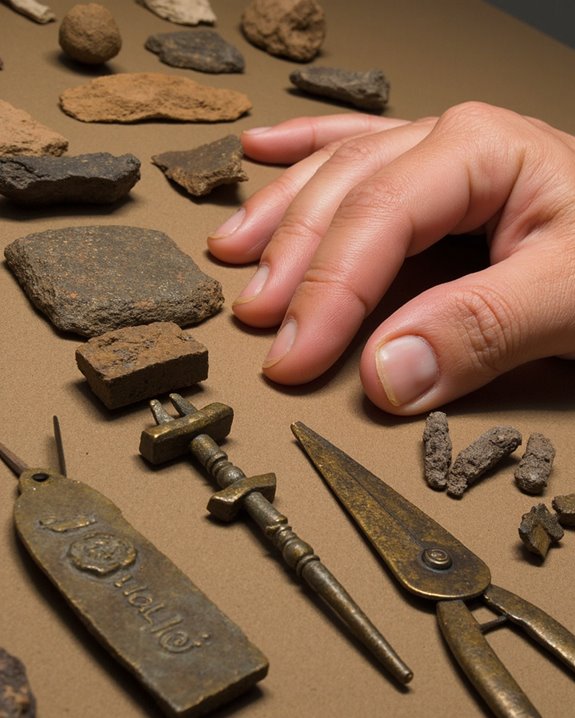
While ancient tools provided our ancestors with practical solutions for nail management, understanding why these implements were necessary requires examining the biological foundation of nail growth itself. Our nail growth pattern dates back to prehistoric times, evolving specifically to match our ancestors’ lifestyle needs. The differential growth rates—fingernails growing twice as fast as toenails at 3.5 versus 1.6 millimeters monthly—reflect evolutionary adaptations to varying levels of natural abrasion.
The big toe’s faster growth compared to other toes, documented since 1937, demonstrates nature’s response to increased stress during barefoot movement. This continuous growth throughout our lives guaranteed primitive humans could maintain functional nails despite daily wear from survival activities like hunting and digging, eliminating the need for specialized trimming tools that would later become necessary with civilized lifestyles.
The Role of Daily Activities in Nail Maintenance
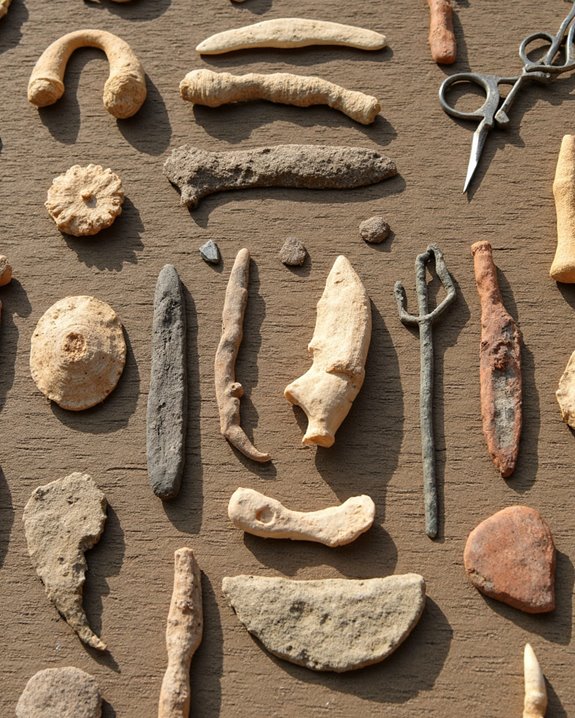
Ancient humans rarely needed nail-trimming tools because their daily survival activities provided natural maintenance solutions that we’ve lost in our modern lifestyles. When our ancestors walked barefoot across rough terrain, the constant friction naturally wore down their toenails, preventing overgrowth. Similarly, using their hands to dig for tubers, scrape animal hides, or fashion tools created continuous abrasion that effectively kept fingernails at manageable lengths.
Studies of great apes and early human relatives show consistent wear patterns that support this passive maintenance system. Unlike today, prehistoric humans didn’t need to deliberately trim their nails—the nails simply wore down at approximately the same rate they grew, about 1.6 millimeters per month for toenails. This natural balance shifted markedly when humans adopted farming lifestyles, reducing the daily physical contact with abrasive surfaces.
Cultural Practices of Nail Care Across Ancient Civilizations

Cultural practices surrounding nail maintenance varied dramatically across ancient civilizations, reflecting both practical necessities and social conventions of their time. In Egypt, I’ve found that people often used pumice stones and natural abrasives for filing, while Greeks and Romans preferred keeping their nails short as a sign of status and cleanliness. This cultural significance of nail appearance remained consistent across societies, though methods differed considerably.
Mesopotamian populations crafted specialized tools from bone and stone, demonstrating their ingenuity in personal grooming. Archaeological evidence suggests that by the 8th century BC, small blades and primitive knives were commonly used for nail cutting in many societies. I’ve noted that some cultures also embraced more natural approaches, allowing manual labor to wear down nails or using teeth when tools weren’t available, practices that addressed practical needs while reflecting societal values.
Natural Materials Used for Filing and Abrading
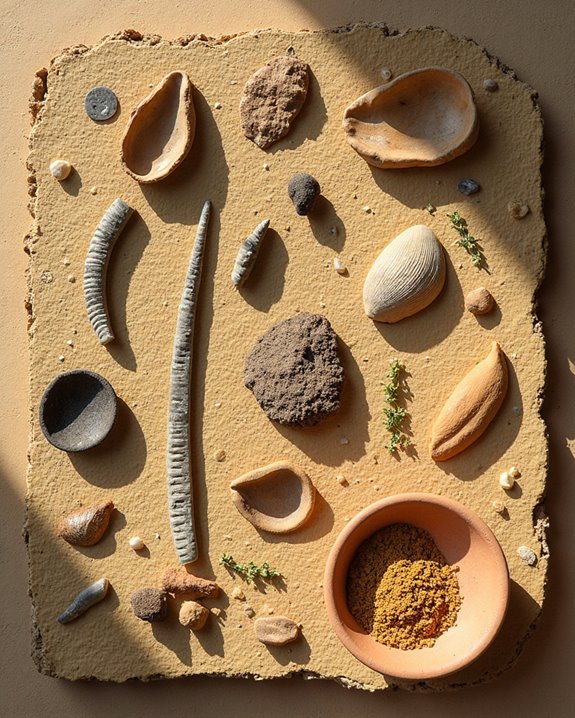
Long before the invention of specialized trimming tools, humans relied on naturally occurring materials to maintain their nails. I’ve found that pumice stone, a lightweight volcanic rock with a naturally abrasive texture, served as one of the earliest forms of nail file in prehistoric communities. This versatile material was widely available across geographic regions where volcanic activity occurred.
In daily life, our ancestors would simply abrade their nails against rough surfaces like ordinary rocks, which effectively filed them through regular contact. When rocks weren’t available, shells provided an excellent alternative, their hard, irregular surfaces perfect for nail maintenance. This practical approach to nail care became especially important as human lifestyles evolved to be less physically demanding, requiring intentional maintenance to replace the natural wear that once occurred.
The Shift From Barefoot to Footwear: Impact on Toenail Care

While humans roamed barefoot across the earth’s varied terrains, their toenails were naturally maintained through constant friction with the ground. This natural abrasion system effectively filed down nails, requiring minimal intervention for thousands of years.
When our ancestors adopted agriculture around 10,000 years ago, their lifestyle became more sedentary, reducing the natural wear on toenails. The situation changed dramatically with the introduction of footwear, which protected feet but eliminated the terrain’s filing effect. This protection allowed nails to grow unchecked at 1.6 millimeters monthly, with big toenails growing even faster.
This evolutionary disruption necessitated new approaches to nail trimming, as our bodies continued producing nails designed for a barefoot existence. Early humans subsequently developed alternative maintenance methods using simple tools, adapting to this unexpected consequence of civilization’s progress.
The Development of Specialized Nail Cutting Implements
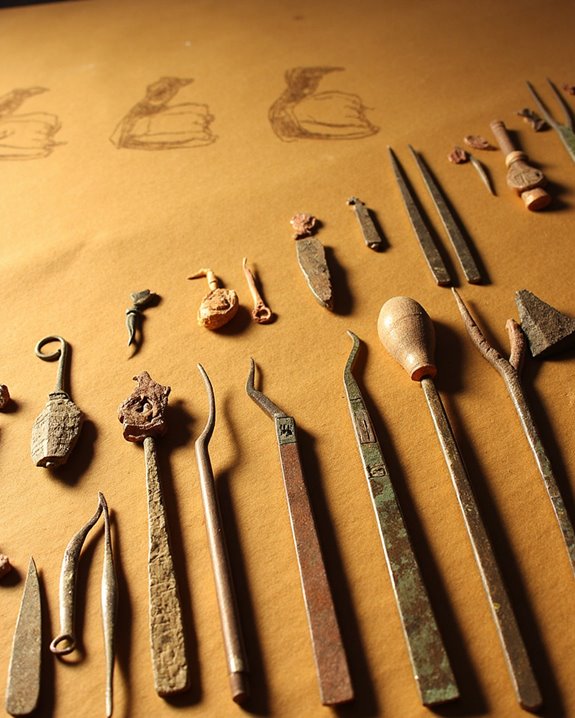
As humans adapted to wearing footwear, they faced a new challenge: how to trim their continuously growing nails. I’ve discovered that early civilizations crafted rudimentary implements from available materials like stone and bone, allowing for more precise grooming than simply filing nails against rough surfaces.
The significant breakthrough didn’t come until the late 1870s, when the first true nail clippers emerged. These devices featured a simple lever mechanism that revolutionized personal care. As industrialization expanded, high-quality stainless steel nail clippers became mass-produced, making them affordable and accessible to average households.
The compound lever design, with its concave cutting edge, provided unprecedented precision for nail maintenance. These specialized tools marked a dramatic improvement in hygiene and effectiveness compared to earlier methods, fundamentally transforming how people approached nail care.
Grooming Rituals and Hygiene Standards in Early Societies
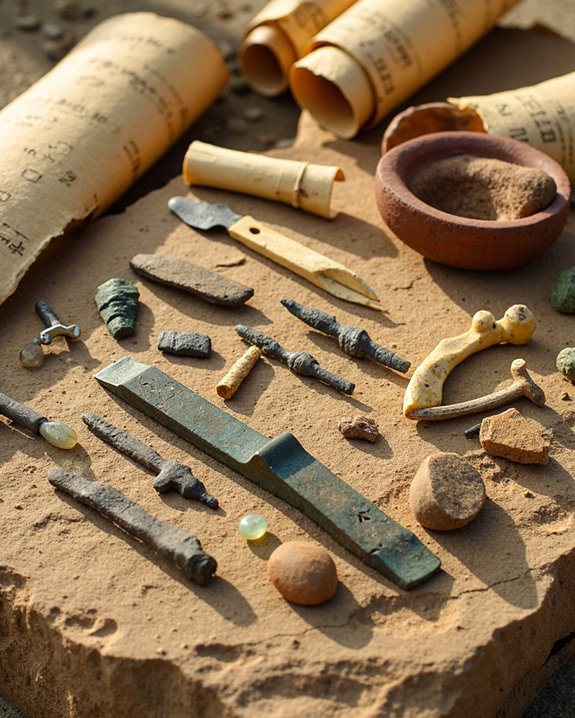
Why did our ancestors devote such attention to nail maintenance despite their limited tools? The answer lies in fundamental hygiene concerns that transcended technological limitations. In early societies, nail care rituals often involved chewing or biting nails after bathing when they were more supple, a practice that served basic cleanliness needs in communal settings. Our ancestors also relied on natural abrasion from daily activities, allowing barefoot walking and manual labor to keep nails functionally trimmed.
Ancient civilizations eventually developed rudimentary tools from natural materials like stones and shells for filing, reflecting evolving grooming standards that emphasized short nails for health reasons. These practices weren’t merely aesthetic; they represented critical hygiene standards in environments without modern sanitation, as longer nails could harbor pathogens and dirt, potentially compromising individual and community health.
Frequently Asked Questions
How Did They Cut Their Nails Before Nail Clippers?
Like Odysseus ingeniously adapting to challenges, I’d fashion my own nail care. Before clippers, I’d resort to biting nails, filing them with rough stones, or using sharp objects like primitive knives or shells.
How Did the Romans Cut Their Nails?
I believe Romans maintained their nail hygiene by biting, using small knives, or abrading against rough surfaces like shells. The wealthy might’ve had special tools as part of their Roman hygiene routines – no clippers needed!
How Did People Cut Their Toenails in the Olden Days?
Ever wonder about Ancient Footcare? I’d say our ancestors trimmed their toenails by chewing them, using stones, shells, or simply letting natural abrasion from barefoot walking do the work. Primitive but effective!
How Did Cavemen Cut Hair and Nails?
I’ll tell you about Caveman Haircuts – they didn’t “cut” as we do. I’d say they managed hair by breaking or pulling it, while their nails naturally wore down from daily activities or they’d bite them off.

